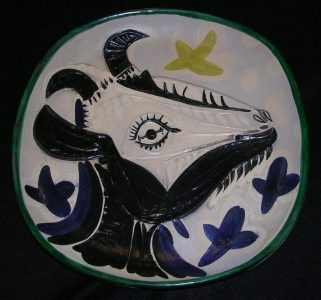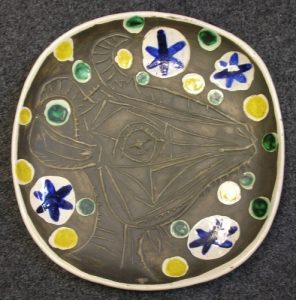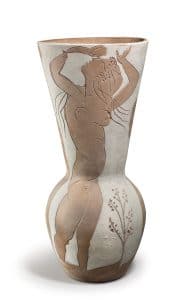
Picasso’s adventure in mass-producing ceramics began in 1947, at age 65. In John Richardson’s words, he “moved to a small house hidden away on the outskirts of Vallauris, a town a few miles inland from Cannes. Vallauris had been a pottery town since Roman times. Over the years, it had become the save of schlock. However, Picasso’s ceramics would reestablish the place’s prestige…. This is the house, La Gauloise, the…house that Picasso bought, because it was very, very difficult to find—it’s in a tangle of little back-streets. He also chose it because in this building here [in front of the house] lived a mad lady called Madame Boisier, who was a kind of concierge but told everybody that he didn’t live here, Picasso was no good as a painter, go away! She was a teacher of dancing, free dancing, and occasionally in the bushes here you would see middle-aged women dressed as nymphs cavorting around. You then ran the gauntlet of all this and over there you would find the villa where he lived with Françoise.” (Picasso: Magic, Sex, Death, lectures on DVD, 2003) It is in the town of Vallauris that Picasso took up pottery in earnest, which is something for which we color-starved Picasso print collectors are eternally grateful.
To be practical, rooms need color, and it can admittedly get somewhat monotonous to decorate only with black and white prints, even if you use gold leaf for the framing. Picasso’s prints in color, or at least the better prints in color, tend to be rather pricey, though there are some exceptions to this rule. Picasso’s editioned ceramics are a notable exception. Some of them are breathtakingly beautiful, much more so when viewed in person than in a text or online. Many are suitable for framing, or simply hanging on the wall with a plate hanger. The ceramics bear the added advantage over prints and drawings in that they may be framed without glazing, so that glare issues are eliminated and the appreciation of the work is much more direct.
Let’s start with a discussion of originality as it applies to the editioned ceramics. These ceramics fall into essentially two categories. In the first type, Picasso created a prototype by painting on a blank ceramic, which design was then reproduced by artisans in the factory. These ceramics, then, in the strictest, modern sense of the word, would not be considered “original”. The underside of these pieces bear an appropriate designation, painted and/or stamped, such as “Edition Picasso” or “Madoura d’apres Picasso” and may or may not be numbered. They may be engraved, but are not in relief. That is, there may be linear or other depressions, but not raised areas, as part of the design.
The second type of editioned ceramics is that in which Picasso created the template for the piece in relief with his own hand. He accomplished this by various means. Typically, he incised wet clay directly, with then served as a template for the edition. In a few rather wonderful cases, the block of linoleum which had been used for a print edition on paper was then impressed onto wet clay. In both cases, the clay templates then yielded editions of ceramics with Picasso’s original incisions either projecting out from the background in relief or appearing as depressions. Madoura quite reasonably named only these ceramics “original prints by Picasso”. The undersurface of these ceramics also bear an appropriate designation, typically “Empreinte Originale de Picasso” (Original Print by Picasso), and just as the other editions may or may not be numbered.
To enable you to make this distinction in the tables below, I have simply classified these two types of prints with a simple Y (yes) or N (no) in the category of originality. Collectors of Picasso ceramics do not however seem to care that much about this distinction, rather guaging their choices by the beauty of the individual designs, as well as of course by other criteria such as size, color, and rarity. The original ceramic prints tend to be more beautiful anyway, because of more compelling designs as well as because they are in relief. For this reason as well as for their greater originality, they generally command higher prices.
There is much more individual variability between the various “impressions” of a given edition of ceramics than among those of Picasso’s prints on paper. The photograph that you see in the Ramie catalogue or elsewhere may correspond to a greater or lesser degree to the piece that you are actually considering for purchase, so it is vital that you at least see a photo of the available piece before you pull the trigger. It is not unusual for the nicest variants to be omitted from the photographs in the catalogue.
At times, Ramie has assigned different catalogue numbers to each of a series of ceramics, yet the entire series is quite similar with only minor differences. When these differences do not significantly affect the beauty or cost of the pieces, for practical purposes I have chosen to lump the entire series into a single table entry. In such cases, the rarity category reflects the summed entire production of the various related editions.
One additional note about the tables in this ceramic chapter: The reference numbers correspond to the most widely used catalogue raisonné of the editioned ceramics by Alain Ramie, entitled Picasso: Catalogue of the Edited Ceramic Works 1947-1971 and published by Madoura Pottery in Vallauris. As you can see, several categories have been eliminated from the tables as they do not apply to the ceramics. These include the signature category, as Picasso signed none of the editioned ceramics (as opposed to his unique ones, which are usually signed).
| A. Ramie # | 77-79 | 84-89 | 106-111 | 112 | 113 | 114 | 115 | 116 | 117 | 122 |
| Beauty | * | * | * | ** | ** | ***** | **** | **** | * | * |
| Significance | ***** | ***** | ***** | |||||||
| Rarity | * | **** | **** | **** | **** | *** | * | |||
| Size | *** | ** | ** | ** | ** | ***** | ***** | ***** | **** | ** |
| Cost | * | * | * | * | *** | **** | **** | ***** | *** | * |
| Desirability to cost ratio | ** | * | ||||||||
| Original Print | N | Y | Y | Y | N | Y | Y | Y | N | N |
Legend:
Rarity: * = 200-300, ** = 110-199, *** = 50-109, **** = 25-49, ***** < 25
Size (in cm): * < 21, ** = 21-34, *** = 35-40, **** = 41-60, ***** > 60
Original Print: Y (yes) or N (no)
| A. Ramie # | 123 | 124 | 125 | 129 | 130 | 131 | 132 | 134 | 141 | 145-150 |
| Beauty | * | * | *** | ** | *** | ** | ** | ** | *** | *** |
| Significance | *** | * | ** | * | * | * | ||||
| Rarity | * | * | *** | **** | *** | **** | **** | *** | ||
| Size | ** | **** | ***** | ** | ** | ** | ** | ** | *** | **** |
| Cost | * | ? | *** | ** | ? | * | * | * | ** | ** |
| Desirability to cost ratio | * | * | * | * | * | |||||
| Original Print | N | N | N | Y | Y | Y | Y | N | N | Y |
au Profil (Ramie 151)
Please refer to my discussion of these wonderful goats in this webpage of our catalogue.
Of all of the several variants of this editioned ceramic (they vary in the way they were painted and in the extent to which they were glazed), the goat in the starry night (shown above on the right) shows off Picasso’s geometric carving the best, because colored paint does not distract from the geometric relief, and the matt glaze of the goat accentuates the relief. This variant could be aptly subtitled “Anatomy of a Goat”, as Picasso’s triangles and ellipses create a surreal, pseudo-anatomic depiction of the angles of a lovely goat’s profile. The starry night variant also appears to be a rare one—a couple of other experts as well as I have never seen it elsewhere, apart from one sighting in the distant past at the Picasso Museum in Antibes.
The black-and-white goat variant is the next best at accentuating the relief pattern and, because of its lovely coloration—a partly white face and white clouds on a light bluish-gray sky—has a lighter, happier feel. All these goats, however, bear a distinct smile, which reliably evokes a corresponding one in the viewer.
We’ve named this goat Esmeralda, after Picasso’s eponymous pet. Due to Esmeralda’s happy face, the brilliant Geometrism with which Picasso carved her, the lovely ways in which she has been painted and glazed, and her substantial, life-like size—this plate is pleasingly massive—this is the best of Picasso’s editioned ceramics, at least in my wife’s and my opinion (and we don’t always agree!). We also hold the five female portraits transferred from linoleum cuts to clay (especially the large one, Ramie number 518, but also Ramie 520-523), at the same level of achievement, but take the comparison no further, since goats and women are like apples and oranges.
| A. Ramie # | 151-155 | 193 | 213 | 214-216 | 218 | 220 | 224 | 237 | 242 | 255 |
| Beauty | ***** | *** | * | **** | * | ** | * | *** | **** | *** |
| Significance | *** | * | **** | ** | **** | ** | ||||
| Rarity | * | * | **** | *** | * | *** | ||||
| Size | **** | *** | *** | ** | *** | *** | ** | ** | **** | * |
| Cost | ** | ** | ** | * | * | ** | *** | * | *** | *** |
| Desirability to cost ratio | *** | * | **** | * | * | * | ||||
| Original Print | Y | N | N | Y | N | N | N | N | Y | N |
| A. Ramie # | 256-257 | 264-265 | 266-267 | 284-285 | 288 | 291 | 292 | 294 | 295 | 308-309 |
| Beauty | * | * | * | **** | ** | * | * | * | * | *** |
| Significance | *** | |||||||||
| Rarity | * | * | * | **** | **** | *** | *** | * | ||
| Size | * | * | * | *** | ** | **** | ** | ** | ** | **** |
| Cost | * | * | * | * | * | *** | * | * | * | * |
| Desirability to cost ratio | *** | ** | *** | |||||||
| Original Print | Y | Y | Y | N | N | Y | N | N | N | Y |
| A. Ramie # | 312-314 | 337 | 357 | 382 | 383 | 385 | 399 | 407 | 457 | 481-488 |
| Beauty | * | * | ** | * | * | * | *** | ** | ** | * |
| Significance | * | |||||||||
| Rarity | *** | *** | ** | * | *** | |||||
| Size | * | *** | *** | ** | * | * | **** | ** | *** | ** |
| Cost | * | ** | ** | * | * | * | * | * | * | * |
| Desirability to cost ratio | * | |||||||||
| Original Print | Y | Y | Y | Y | Y | Y | N | N | N | N |
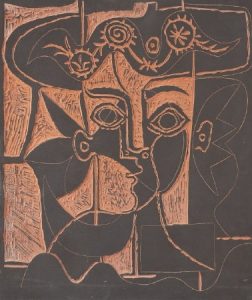
Femme (Ramie 518)
Please refer to the discussion of this ceramic masterpiece on its webpage.
| A. Ramie # | 509 | 517 | 518 | 520 | 521 | 522 | 523 | 538 | 569 | 571 |
| Beauty | ** | *** | ***** | ***** | ***** | ***** | ***** | *** | ** | ** |
| Significance | **** | ***** | ***** | ***** | ***** | ***** | ** | |||
| Rarity | *** | *** | *** | *** | *** | *** | *** | *** | *** | *** |
| Size | ** | **** | **** | ** | ** | * | * | ** | ** | ** |
| Cost | * | *** | *** | ** | ** | ** | ** | * | * | * |
| Desirability to cost ratio | * | ** | ** | ** | ** | ** | *** | ** | ** | |
| Original Print | Y | Y | Y | Y | Y | Y | Y | N | Y | Y |
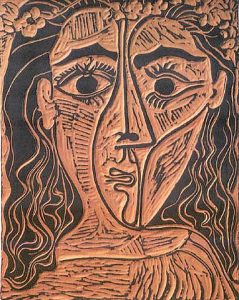
| A. Ramie # | 572-573 | 575 | 581 | 587 | 590 | 592 | 596-598 | 600-601 | 602 | 603 |
| Beauty | * | * | ** | * | * | * | ** | * | * | * |
| Significance | ||||||||||
| Rarity | ** | *** | *** | *** | *** | *** | ** | |||
| Size | ** | ** | ** | ** | ** | * | ** | ** | ** | ** |
| Cost | * | * | * | * | * | * | * | * | ** | * |
| Desirability to cost ratio | ||||||||||
| Original Print | Y | Y | Y | Y | Y | Y | Y | Y | N | N |
| A. Ramie # | 608 | 609 | 611 |
| Beauty | * | * | * |
| Significance | |||
| Rarity | * | ||
| Size | ** | ** | ** |
| Cost | ** | ** | * |
| Desirability to cost ratio | |||
| Original Print | N | N | N |
